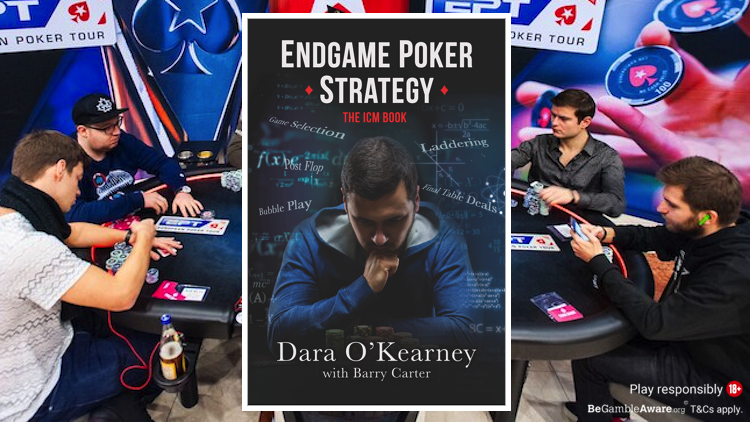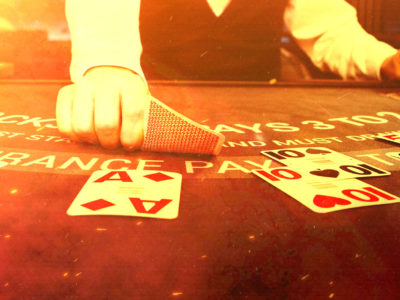You’ve no doubt heard about “ICM” and how important it can be in tournaments. Need an explanation of the concept and how it applies? We’ve got a book recommendation for you.
In their new book Endgame Poker Strategy: The ICM Book, Dara O’Kearney and Barry Carter take a deep dive into the Independent Chip Model (ICM) — the most important strategy concept in tournament poker. However, there are some leaks you can fix right away to your ICM game before you read the book. Make these changes to your game and you will instantly boost your MTT winrate.
Here is an excerpt from Endgame Poker Strategy discussing how ICM affects decision-making at various stages of a tournament, in particular as the cash bubble approaches, after making the money, and at the final table.
Losing hurts more than winning feels good
This is perhaps the philosophy of ICM that you should internalise right away. Because there is not a 1:1 ratio of chips to cash like there are in ChipEV cash games, you never win more than you risk in a tournament hand. You might be calling a 500 chip bet to win a 1,000 chip pot, which is a healthy return on your chips, but you might be risking $50 in tournament equity to win an extra $30.
The immediate adjustment, therefore, is to play tighter in tournaments than you would in cash games. You need to play stronger hands than you would in a cash game because you need to win more often to justify the risk.
In practice that means shaving the bottom of your range a little, especially when you are calling a bet. If your calling range in a cash game would be 44+ KJs+ ATo+ A9s+, maybe take a few pips off that range to make it 77+, KQs, AQo+, AJs+.
In particular you should dramatically tighten up your calling range near the bubble, with at a minimum something like 88+, AQs+, AJo+ but probably something even tighter. You will not be making a massive mistake, until you have learned more about ICM, by only playing QQ+ and AKs on the literal bubble of a tournament.
You’ll learn what factors widen or tighten your calling range as we progress but until then, keep it to hands you figure to be ahead most of the time.
Small pairs lose their value
A specific note on hand selection and that is that small pocket pairs that you would be happy to set mine with in a cash game go dramatically down in value in tournaments as you get nearer the money. It is not a bad idea to remove pairs below sixes entirely from your range when you are near the money and/or with shallow stacks.
This is in part because the hands you will get called by will tend to dominate them or at least be overcards. It is pretty much never a good thing to get in coinflips in the late stages of a tournament, even though they are an aspect of televised poker that is glamourised. Also, small pairs realise equity poorly, there are so many flops where you will be forced to fold because small pairs are too weak to stand much ICM pressure. If you have 55 and the flop is 9-T-K you cannot put any more money in the middle and are at best hoping to check it down.
Most of the time the stacks are shallower when ICM influences the action, so you usually won’t be getting the implied odds to play small pairs anyway.
It feels weak at first to just open fold a pocket pair in a tournament but overvaluing the ‘best hand right now’ is a particularly dangerous leak. There are times when small pairs play well, but until we discuss them, just throw them away.
Blockers go up in value
On the flip side, you can make up for the small pair removal by adding more hands that block big hands. You will discover that suited Aces and suited broadway hands go up in value in the late stages of a tournament.
This is because when you have an Ace in your own hand it makes it less likely your opponent has one. Because you need a tighter calling range in tournaments, you are more likely to get folds when you have an Ace in your hand because the typical calling ranges are mostly made up of AA, AK, KK, QQ, JJ hands. If you raise with 22 there are 16 potential combinations of AK and six combinations of AA out there, for example, but if you raise with A2s there are only 12 combinations of AK and three combinations of AA. You will run into a big Ax hand 30% less often in this example with A2s than you will with 22.
The same is true to a lesser extent with suited broadway hands like K9s and QTs. Think of those hands as having ½ or ¼ of a blocker. They will play better in late position, if you raise them early you will almost certainly run into Ax. We like the Ax and Kx hands to be suited because it gives us outs when we do get called and we are otherwise dominated. If you get reraised and have plenty of chips behind, just throw the hand away.
When you do get dealt a hand like A5s and you raise with it don’t tell yourself you are raising because you have a strong hand, tell yourself you are raising because it is much less likely your opponents have a hand they can continue with.
Who covers whom is important
The nearer you get to the money the more significant your risk of elimination becomes in your decision making. You should always pay attention to who can bust you at your table, who is close to busting and who is somewhere in the middle.
You can play a wider range of hands against a player you can bust, because they have to play tighter against you. You can play more aggressively against a player you cover and take them off more pots. Fold equity becomes very important in the late stages of a tournament when the blinds are high, so maximise your chances of taking down pots uncontested.
If you are the player who is covered, you should play more passively and take fewer risks. Pot control your hands, avoid thin value bets and be prepared to fold in hands you would probably call in a cash game. Your opponent should be playing more aggressively against you, so a more passive style should earn you more chips overall anyway.
The bigger your stack, the more aggressive you can be. If you only have 5% more chips than your opponent then they represent almost as big a threat to you as you do to them. When you have twice as many chips as them you can take liberties. Likewise if you have a very short stack do not expect to intimidate many people, but if there is a player whom you can hurt because they are also short, they should be your target for aggression.
Play tighter as the short stack
This goes against a lot of prevailing wisdom and instincts. Many people believe that when they have a short stack they have to gamble to avoid being blinded out. That is a fallacy. The fewer chips you have the more each one is worth in terms of equity.
The few chips you have are worth more to you than they are to the other players, so they need protecting. It may feel counterintuitive but the shorter your stack, the tighter you should play. How tight is hard to say without further study, but for now just narrow your range as much as you can bear when you get short stacked.
If you are going to pick a player to steal from while you are the short stack, target the next shortest player. They will not want to become the short stack and they are the player you can threaten the most. While it is true that a big stack will call you with a wider range of hands you can beat, it is better to take the pots down uncontested wherever you can.
ICM is most extreme on the bubble and final table bubble
Most of you probably know that you should play much tighter on the bubble, it probably makes perfect sense; it is the last time you can bust before securing a mincash. Even amateur players who have never heard the term ICM realise this and you will see them stalling near the bubble. You need a very strong hand to risk elimination on a tournament bubble, and you will discover in this book there are plenty of spots where Pocket Kings is a fold, and Ace King suited should be an easy fold.
However, when you have a big stack, this means you can exploit how tight people should fold by being more aggressive. If you have a very big stack you should try and extend the bubble as long as possible to pick up lots of small pots from people hanging on until the money. The flipside of having to play very tight as the short stack is that you can play very aggressively as the big stack and the bubble is where you can do that the most.
What fewer people know is that ICM is at its second most extreme on the bubble of the final table. This is because most of the money is on the final table and the pay jumps get bigger with each elimination. You should, therefore, play almost as tight just before the final table.
Although there is the most money on the final table, while ICM plays a big role it does not play as big a role as you think once you get there. In fact ICM is less extreme with every elimination. ICM is less powerful with four players left than it is with six players left, because the players have secured more money they cannot lose.
What you tend to see on the final table is players playing very tight because they have their heart set on a particular pay jump. The money for third place might represent something significant for them in their real life, but from an ICM perspective they should not be playing like it’s a bubble.
The quick adjustment before we go further is that with every elimination at the final table you can play looser than the previous pay jump.
Play tighter with flat payouts or a micro/mega stack at the table
The other thing that should significantly tighten your range is when the stack sizes or payouts make it more important to lock up 2nd place than go for the win. One example of this is when the payouts are flatter, ie. 2nd, 3rd, 4th and so on get a much closer prize to 1st place than they typically would.
So a typical final table might payout the final four players like this:
1st: $2,200
2nd: $1,000
3rd: $800
4th: $600
An example of a flat final table payout structure might be more like this:
1st: $1,900
2nd: $1,100
3rd: $900
4th: $700
The same dynamic occurs when there is a runaway chip leader who has, for example, more than half the chips in play, or paradoxically, a micro stack who is going to bust next.
In all three situations, the advice is to play tighter than usual. We’ll get into the reasons throughout this book but when a micro stack is almost guaranteed to hand you a pay jump it would be a disaster to bust before them. When the chip leader is almost guaranteed to win top prize, you should be looking at 2nd place prize money rather than taking big risks to catch up to him in chips. When the payouts are flatter, laddering becomes more profitable. Just take our word for it for now, you will make more money overall by tightening up in these dynamics.
Play smaller fields
You will learn the most about ICM by playing smaller field MTTs, which we define as 50-200 players online. This is because you will find yourself on bubbles and at final tables more often. The reason why SNG and MTTSNG grinders have a deeper understanding of ICM than players who specialise in huge field tournaments is more repetitive exposure to relevant spots.
We also think these tournaments are typically softer overall and much easier to handle from a mental game perspective. At an absolute minimum you should play more small field MTTs while you are learning the ropes about ICM.
There is no ICM heads-up
When there are just two players remaining you have both secured second place prize money and you are now just competing for the 1st place prize difference. This is the only time when you can play a 100% ChipEV style because there is only one prize being contested. You will often see players overfold heads-up because they have been doing it for the entire tournament, but now is the time to take small edges if you think you are ahead in ChipEV terms.
This is an excerpt from Endgame Poker Strategy: The ICM Book by Dara O’Kearney and Barry Carter.
Back to TopView Other Blogs




















